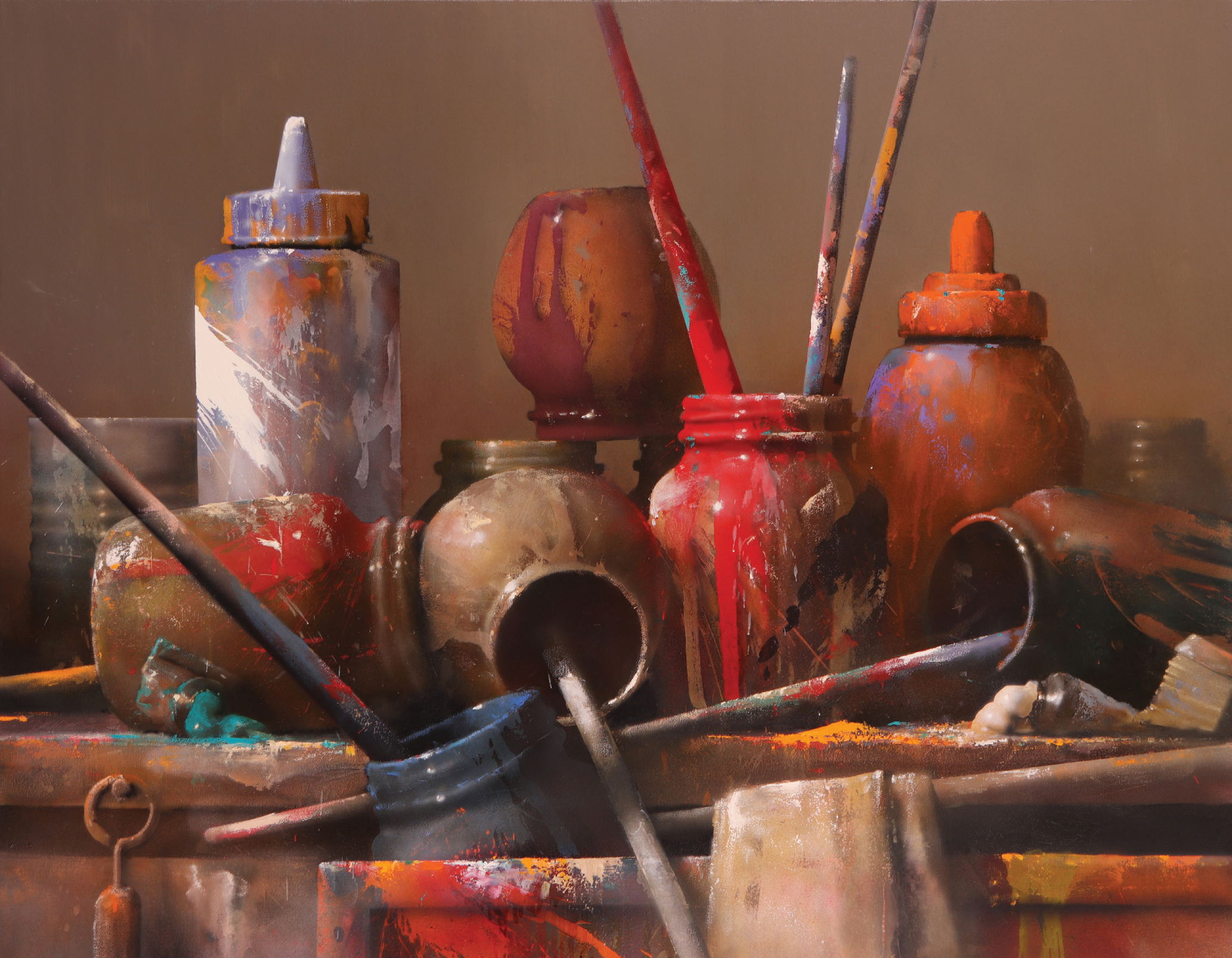
06 May Reimagining the Everyday
IT’S ALL ABOUT AUTHENTICITY,” SAYS ARTIST DAVID DORNAN. “Passion and process are everything for me, because if the passion and joy of the process aren’t there, you might as well be putting hubcaps on at the Ford factory.”
A peripatetic creator, Dornan finds subjects for his artwork in ordinary objects all around him. Known for his series of still-life paintings, he continues working in the tradition of contemporary realism from his home base of Helper, Utah. “I’m not interested in rubber-stamping the things we all find beautiful,” he says. “I want to find beauty everywhere, so I paint the things that are around me.”
On close examination of his paintings — which include images of cups, bottles, studio objects, and flowers — splotches, handprints, and scratches are visible evidence of the way the artist applies paint. There’s an interaction between the two-dimensional and three-dimensional in the work, Dornan explains.
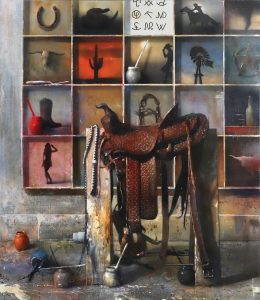
Modern Western | Oil on Canvas | 60 x 52 inches
“David’s paintings are an insight into his world,” says Jordan West, associate director of Meyer Gallery in Santa Fe, New Mexico, which will host Studio Visit, an exhibit of Dornan’s work, June 5 through 11. “He’s so good technically, and his subjects are so familiar and sentimental that they appeal to a broad range of people. And he has an amazing way of being loose and tight at the same time.”
According to Dornan, his most successful artworks result from a meeting between total chaos and absolute control. His process is a curious mix of science and whimsy, and he doesn’t start a painting with any particular plan. “I paint how it feels, and later I make it real with my knowledge,” he says. “I’m an efficiency expert. I figure out how to save two minutes here and five minutes there. I use the logic of realism, light, and perspective. But I also just go crazy. I will have 20 things going. I work on five or six paintings a day, but I have dozens unfinished in the racks. I put some away and then come back — maybe three or four months later — to see why I abandoned them and where they want to go.”
Dornan also draws on his collection of hundreds of varnishes that he hand-mixes to achieve different viscosities, textures, and hues, and then he will load each into a spray can. This allows him to glaze the work and change the light, which he may do dozens of times on a single piece.
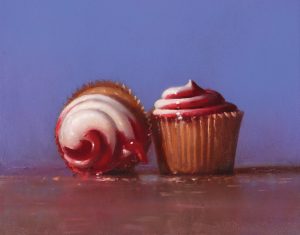
Duo | Oil on Canvas | 13 x 16 inches
“Most artists mix a color, put it on the canvas, and boom, that’s it,” he says. “But I can say, ‘I want this to be a warmer painting or a cooler painting,’ and I can create that with these glazes. I can build up a history that I can also change.”
Dornan works primarily in oil on canvas, but he also uses metal, wood, glass, stone, concrete, chalk, spray paint, and plant matter. “Materials are fascinating to me,” he says, “and I love repurposing things.” He sometimes incorporates old images and found objects into his art, and into his living and workspaces. His backyard has a fire pit made from an ore crusher, a bench made from coal augers, and a series of multi-ton boulders that were removed from Helper’s Main Street during a modernization project.
Dornan’s tools range from sable brushes and palette knives to paper towels, playing cards, pottery ribs, squeegees, carpenter’s snap chalk line, airbrushes, sanders, cosmetic brushes, and a tool he created by attaching paintbrushes to a power drill to make circular patterns. “Everything is a tool to Dave,” says C.J. Hales, Dornan’s studio assistant. “He’ll buy tools and then figure out how to use them.”
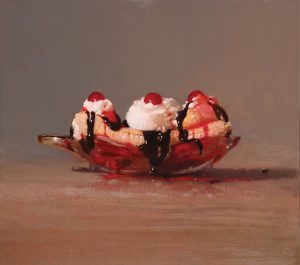
Split | Oil on Canvas | 22 x 24 inches
“I love anything that makes marks,” Dornan says. “In art school, they tell you, ‘This is your brush, this is your palette, go make a painting.’ I tell my students, ‘Go to Home Depot and get your art supplies.’”
Dornan taught drawing and painting at the University of Utah from 1982 to 1999, which allowed him to take a quarter off each year to paint in Palm Desert, California. “That’s where I really got my chops painting,” he says, adding that it was also pivotal to meet David Katz from CODA Gallery, who gave him his first show.
When a restructuring at the university forced him to choose between his artistic lifestyle and the security of academia, it didn’t seem like much of a choice — he had to make art. Dornan resigned from a 17-year faculty position to pursue painting full time.
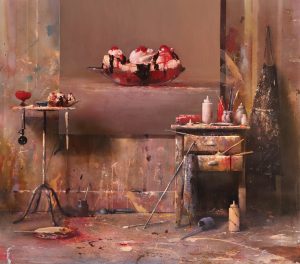
Periphery II | Oil on Canvas | 50 x 45 inches
But he still loved teaching, and this led the artist to organize painting workshops that have since become the starting point for many other talented artists. “Dave has an inner teacher,” says painter Ben Steele, a former student. “He’s incredibly generous in his willingness to share his knowledge, and he’s not threatened by his students’ success.”
When it came time to find a substitute classroom for the workshops, large, affordable spaces that could accommodate both studios and classrooms were scarce in Salt Lake City. So, Dornan looked a hundred miles southeast to the little mining town of Helper, which was slowly fading into the red rock landscape. Most of Main Street was boarded up, and the city had taken over many of the buildings for non-payment of taxes.
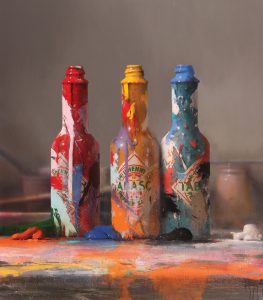
Big Three | Oil on Canvas | 60 x 52 inches
In 1996, Dornan made a deal with the city and purchased a former brothel to house his studio, school, and gallery. He knew there would be a lot of construction work, but he soon realized there was another type of learning curve. He was working on the building when a local resident pulled up to visit the liquor store two doors down. “She was about three-and-a-half sheets to the wind,” Dornan says, chuckling. “She staggered up on to the sidewalk, stared at the gallery sign, and said, ‘What’s all this art bullshit?’”
Since then, Helper — named for the “helper engines” that push coal trains to the top of the hill — has grown alongside the careers of Dornan and his wife, artist Marilou Kundmueller. Over nearly 30 years, Dornan has helped launch the professional careers of a number of emerging artists who he mentored there through workshops, private lessons, and residencies. The workshops and artist-in-residence programs are year-round, and some 700 artists have come through, Dornan estimates.
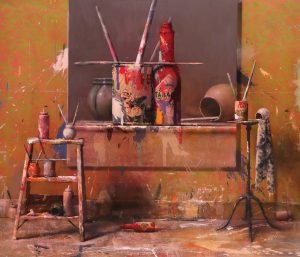
Periphery I | Oil on Canvas | 52 x 60 inches
Many of these former students and colleagues have also decided to stay in Helper, drawn by the affordability, the beauty of the red rock landscape, Dornan’s passion, and the growing art scene. Dornan is credited with playing a major part in shaping the current thriving art community there. In 2019, he received the Governor’s Mansion Award from Utah Governor Gary Herbert. Today, galleries and working studios line the main street, and the town hosts an annual Arts, Music, and Film Festival, an Outlaw Car Show, a Plein Air Festival, and monthly First Friday celebrations.
“I came down for a workshop and just loved every second of it,” Hales says. “Living in the same house, painting together, eating together every night. I saw Dave and Marilou’s relationships with their students and said, ‘What do I have to do to be here? I want to immerse myself in life this way.’ It was an opportunity to work on every aspect of living a life of passion.”
“Dave provides an immersive experience,” adds artist Anne Kaferle, one of Dornan’s former interns. “He teaches observation skills, painting techniques, work ethic, woodshop skills, and the practicalities of navigating the art world. It was an incredibly nurturing environment for me, and a huge stroke of luck that made my dream of painting for a living a reality.”
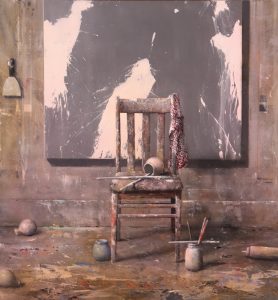
Splatt | Oil on Canvas | 50 x 45 inches
“Art critics always say, ‘This artist paints like that artist, or someone’s style is reminiscent of so and so,’ but I want to see a painting that doesn’t remind me of other paintings,” Dornan says. “So, I love it when students turn my head. It makes me run faster.”






No Comments